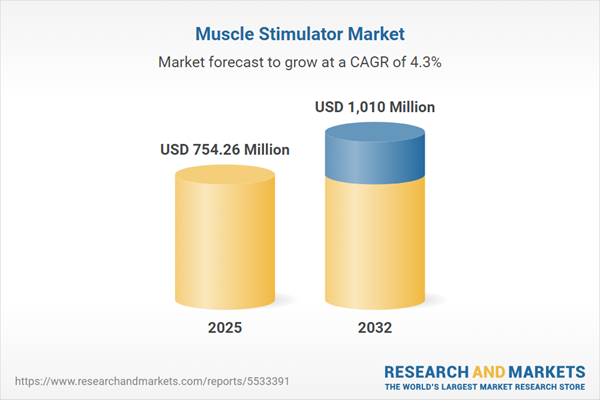Speak directly to the analyst to clarify any post sales queries you may have.
Senior decision-makers in the muscle stimulator market operate in an environment defined by swift digital integration and evolving regulations. As user needs expand across medical, sports, and wellness sectors, organizations must continually adapt their strategies to secure meaningful differentiation and sustainable growth.
Market Snapshot: Muscle Stimulator Market Outlook
The muscle stimulator market is witnessing sustained momentum, fueled by widespread adoption of both electrical muscle stimulation (EMS) and transcutaneous electrical nerve stimulation (TENS) devices. Increased utilization of these solutions in clinical and wellness segments supports patient recovery, optimizes muscle rehabilitation, and elevates pain management outcomes. Digital health integration is reinforcing this progress by allowing care providers to leverage real-time data for targeted interventions and informed decision-making. Regulatory developments are compelling manufacturers to accelerate product launches and diversify use cases, a trend that enhances adaptability across clinical, athletic, and home-based environments. The competitive landscape continues to intensify as organizations deploy advanced digital tools to enhance efficiency and scale personalized care pathways.
Scope & Segmentation in the Muscle Stimulator Market
- Product Types: Portable EMS and TENS devices provide individualized flexibility, while clinical-grade systems address complex rehabilitation needs within professional healthcare settings.
- Applications: Devices are designed to support pain management, neuromuscular therapy, post-surgical rehabilitation, and muscle strengthening for a broad range of users, including healthcare practitioners, athletic coaches, and patients at home.
- End Users: Stakeholders span hospitals, physiotherapy centers, sports organizations, homecare providers, fitness departments, and individual patients, each requiring solutions tailored to specific therapeutic or operational goals.
- Distribution Channels: Goods are distributed through medical equipment distributors, institutional contracts, pharmacies, and e-commerce platforms, expanding procurement options and broadening market presence.
- Geographical Regions: The primary markets are North America, Latin America, Europe, the Middle East and Africa, and Asia-Pacific. Each region presents unique regulatory ecosystems and healthcare infrastructure requirements, demanding region-specific market entry and expansion strategies.
- Leading Technologies: Innovation is driven by modular hardware architecture, therapy customization powered by machine learning, secure remote monitoring features, and mobile solutions that enable immediate, data-supported clinical analysis.
- Key Companies Covered: Major market players include Enovis Corporation, Everyway Medical Instruments, ExcelHealth Inc., Globus Corporation, Healthmate International, Koninklijke Philips, Medtronic plc, EMS Physio Ltd., ManaMed LLC, and Therabody Inc., with each contributing to industry benchmarks and competitive standards.
Key Takeaways for Senior Leaders
- Digital health and cloud-based ecosystems are central to enhancing patient engagement and streamlining care delivery, enabling organizations to swiftly align with dynamic technology trends and service expectations.
- Forging strategic partnerships with regional healthcare providers facilitates compliance with local regulations and user demands, accelerating market entry and enabling tailored product offerings.
- Reinforcing supply chain resilience through continuous review of logistics and supplier arrangements is necessary to reduce vulnerability to regulatory or reimbursement changes across international markets.
- Expanding accessible routes to market through flexible sales models and diversified distribution ensures products meet the diverse needs of urban, rural, and specialized user bases.
- Introducing subscription models and value-added support services drives sustained customer engagement and supports the deployment of advanced monitoring capabilities, reinforcing recurring revenue streams.
- Continuous regulatory oversight and investment in secure digital infrastructure are vital as digitally connected muscle stimulator devices become integral to remote care delivery and clinical workflows.
Tariff Impact: Navigating Policy Shifts
Recent U.S. tariffs on imported muscle stimulator devices have prompted organizations to re-evaluate supplier relationships and broaden distribution strategies. Senior leaders are investing in strategic sourcing and building more robust supply chains to maintain product continuity and adapt to evolving trade policies. Emphasis on integrated digital service models strengthens readiness for regulatory change and market volatility.
Methodology & Data Sources
This report leverages comprehensive secondary research, input from expert interviews, and ongoing analysis of regulatory trends within the muscle stimulator market. Triangulation and scenario simulation underpin the insights, ensuring actionable recommendations for executives and senior stakeholders.
Why This Report Matters
- Empowers organizations to refine operational and commercial strategies in line with changing muscle stimulator market dynamics and global compliance requirements.
- Supports executive teams in risk management and growth planning, ensuring offerings address a wide spectrum of end-user needs and regulatory challenges.
- Enhances leadership capacity to respond to new user expectations and navigate complex industry developments with agility and confidence.
Conclusion
Sustained success in the muscle stimulator market depends on proactive innovation, regulatory adaptability, and continuous operational improvement. Investment in digital tools positions organizations for long-term value and industry relevance.
Additional Product Information:
- Purchase of this report includes 1 year online access with quarterly updates.
- This report can be updated on request. Please contact our Customer Experience team using the Ask a Question widget on our website.
Table of Contents
3. Executive Summary
4. Market Overview
7. Cumulative Impact of Artificial Intelligence 2025
Companies Mentioned
The companies profiled in this Muscle Stimulator market report include:- Enovis Corporation
- Everyway Medical Instruments
- ExcelHealth Inc.
- Globus Corporation
- Healthmate International, LLC
- Koninklijke Philips N.V.
- Medtronic PLC
- EMS Physio Ltd.
- ManaMed LLC
- Therabody Inc.
Table Information
| Report Attribute | Details |
|---|---|
| No. of Pages | 184 |
| Published | November 2025 |
| Forecast Period | 2025 - 2032 |
| Estimated Market Value ( USD | $ 754.26 Million |
| Forecasted Market Value ( USD | $ 1010 Million |
| Compound Annual Growth Rate | 4.3% |
| Regions Covered | Global |
| No. of Companies Mentioned | 11 |









